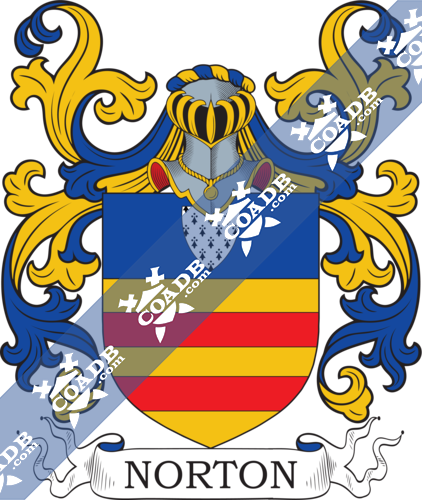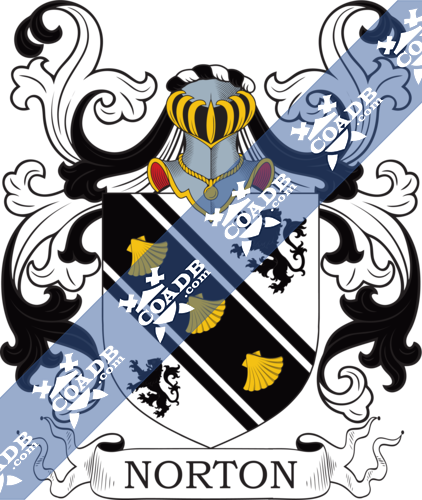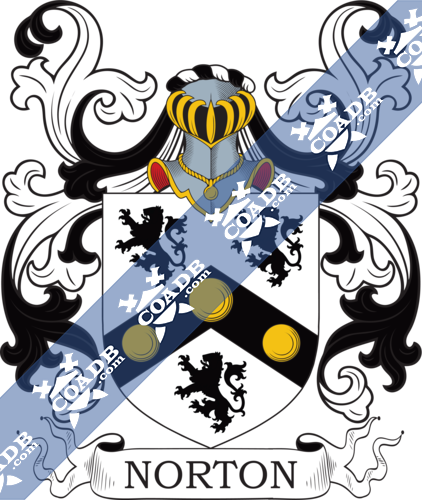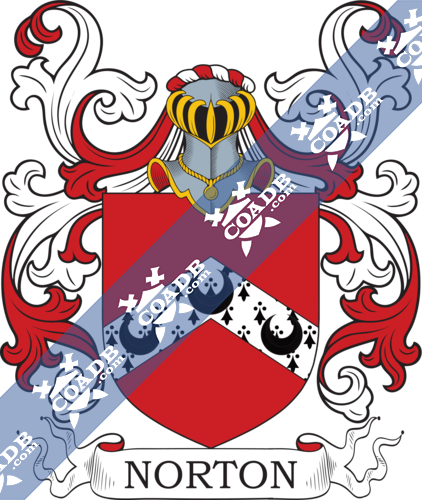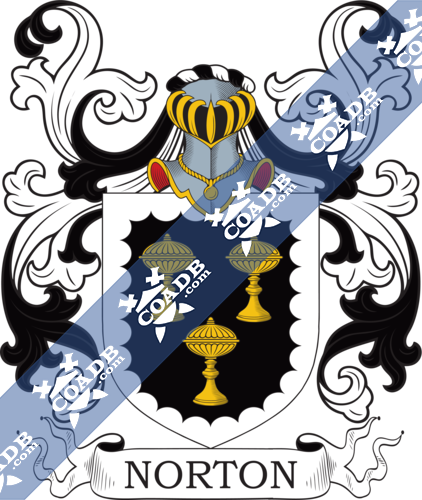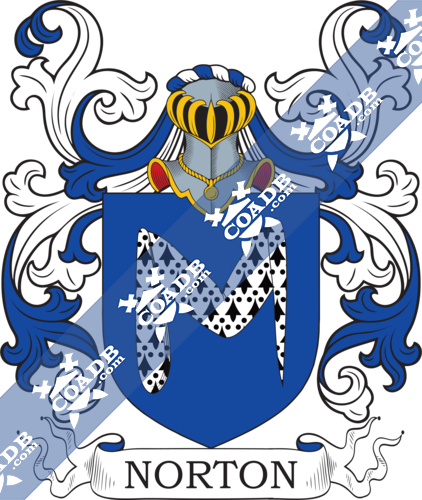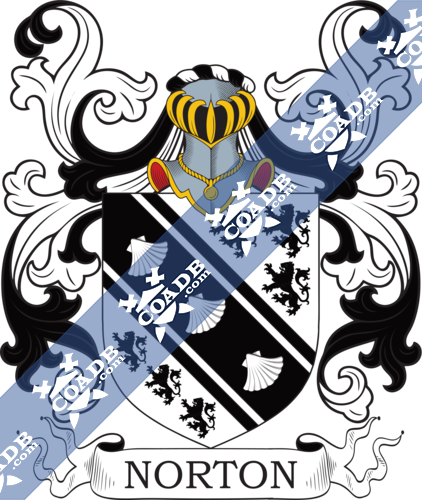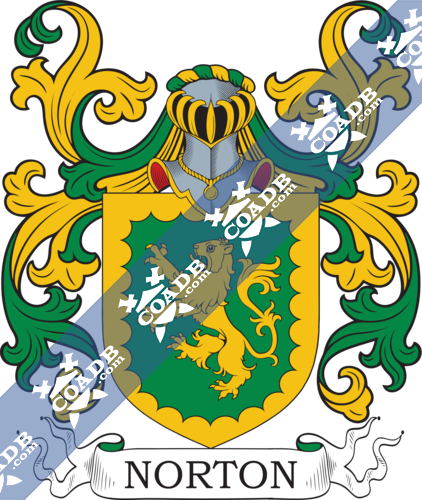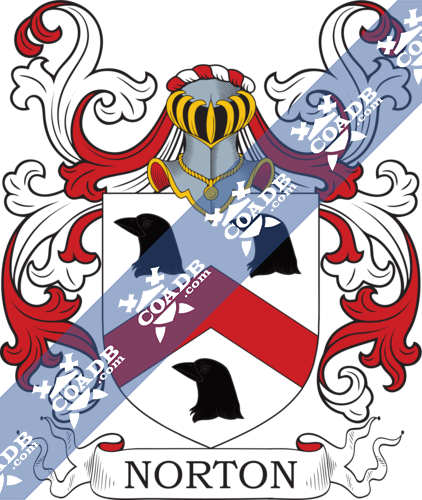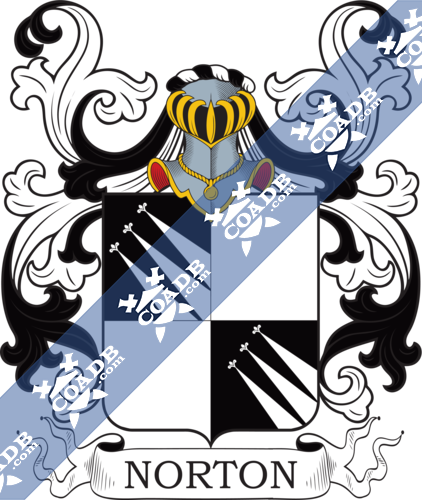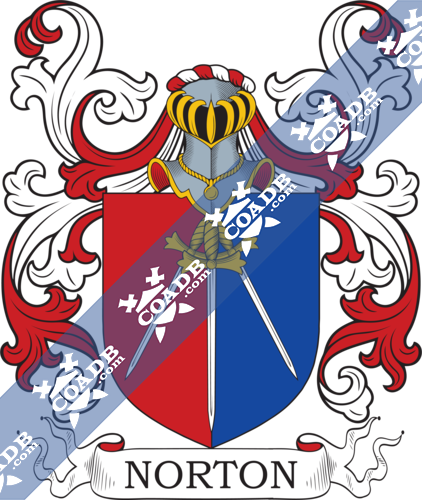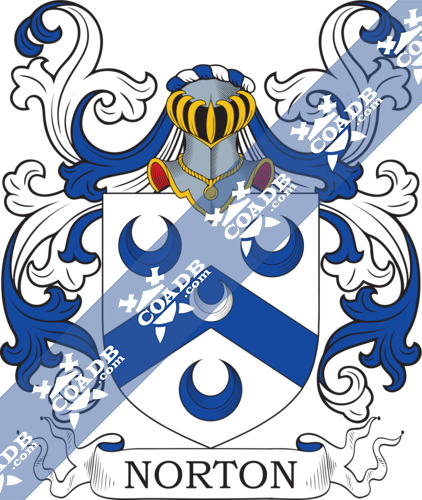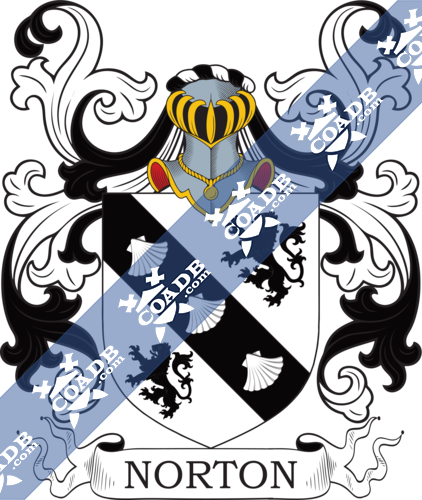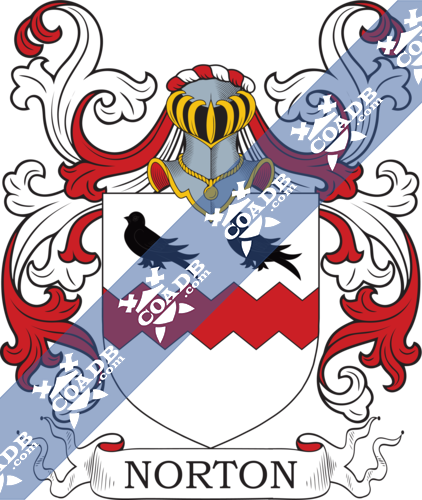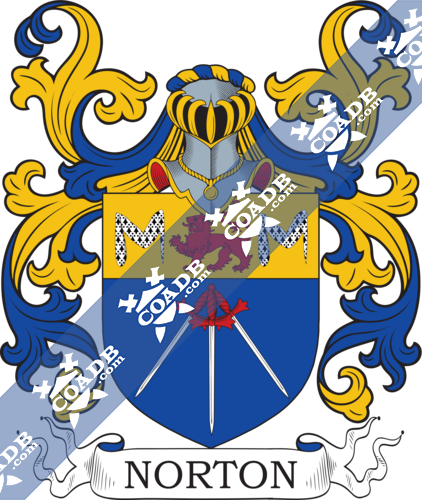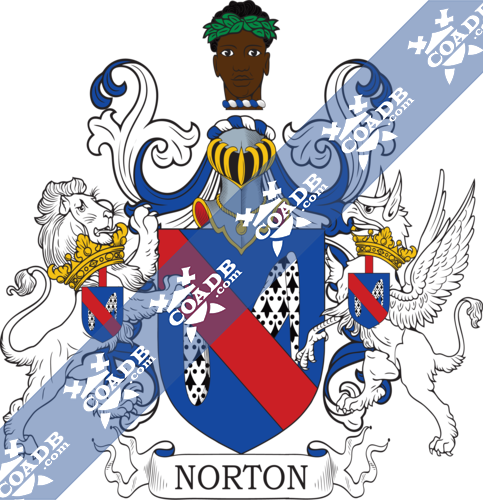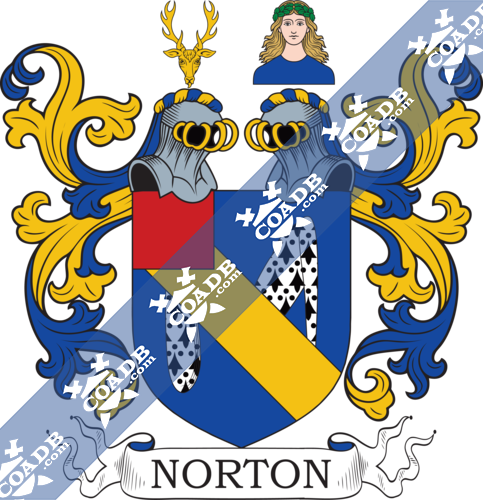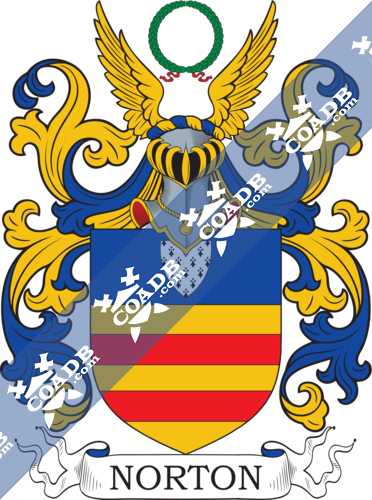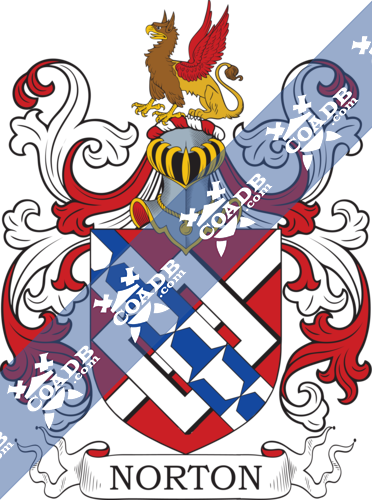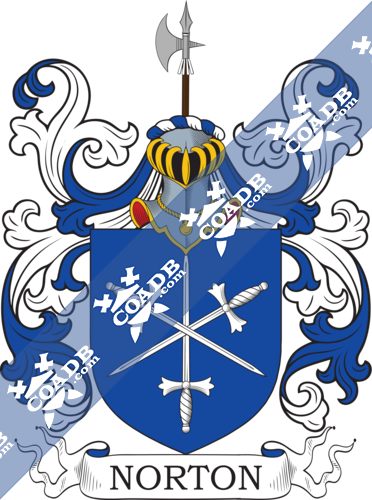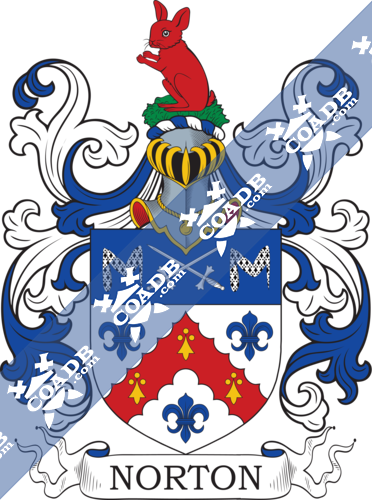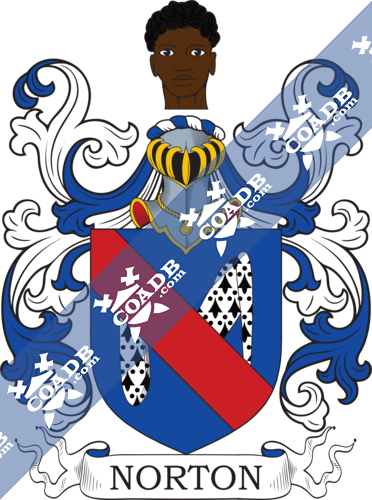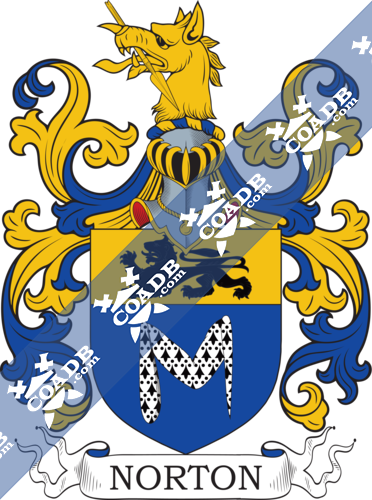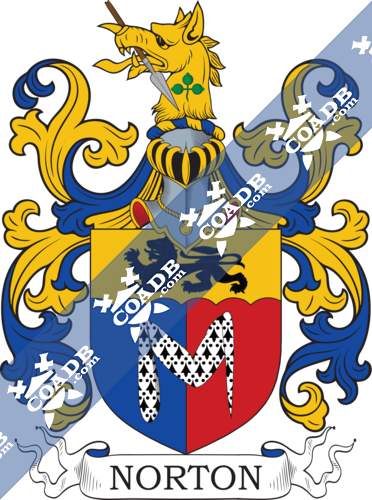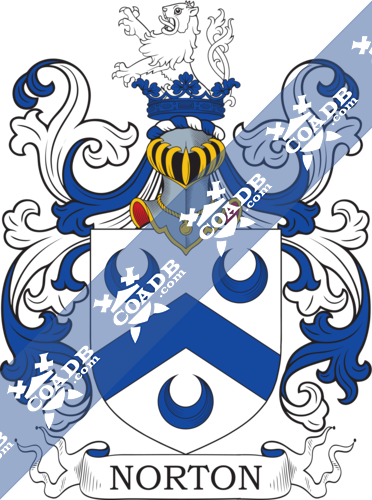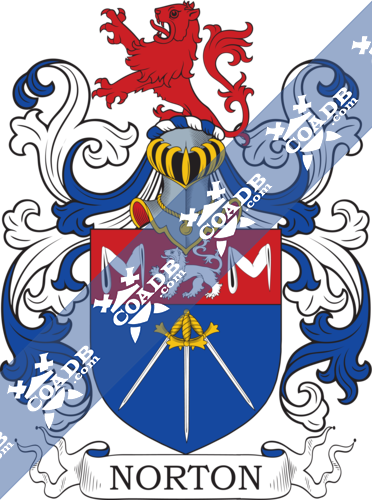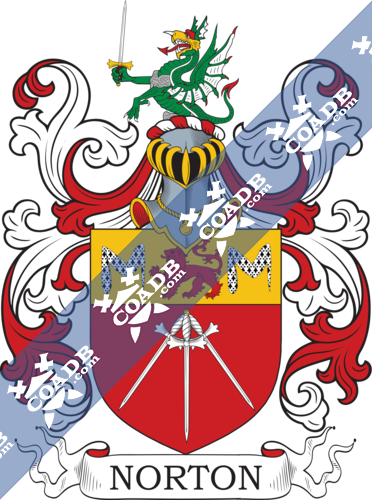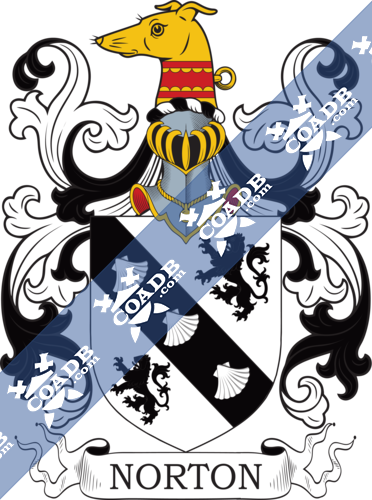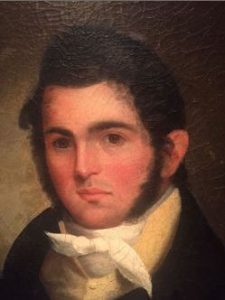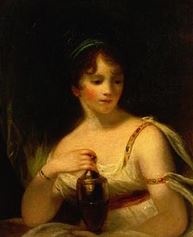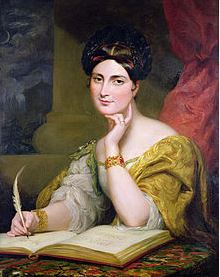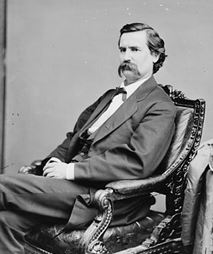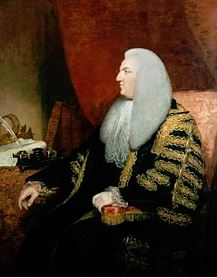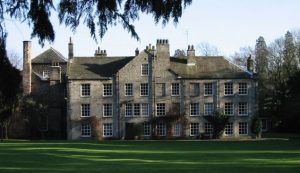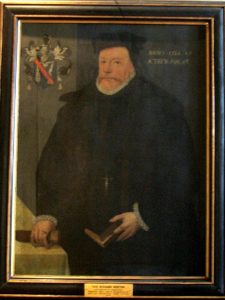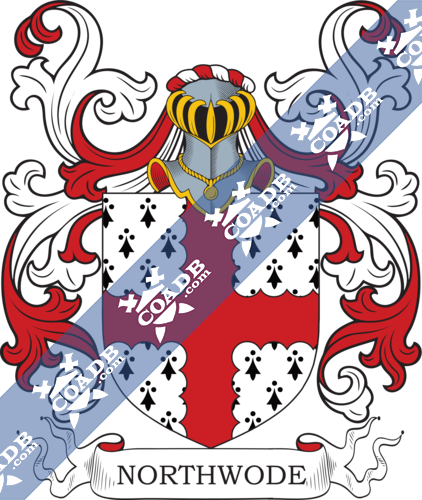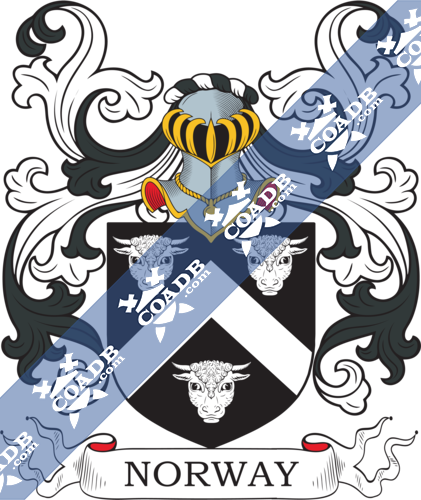Norton Family Crest, Coat of Arms and Name History

Norton Coat of Arms Gallery
Don’t know which Coat of Arms is yours?
We can do a genealogical research. Find out the exact history of your family!
Learn MoreNorton Surname Name Meaning, Origin, History, & Etymology
There are four origin theories and meanings of this surname. First, and primarily, this is a locational or habitational last name meaning “of Norton”, denoting a person who lived in or was from place called Norton, or the north town. There are numerous places throughout the British Isles so name, including, but not limited to Nortone or Norton in Hampshire, England, Norton in counties Staffordshire, Somerset, Durham, and Cheshire, as well as Midsomer Norton, Chipping Norton, and Brize Norton. The name derives from the Old English (or Anglo-Saxon) words norð (north) and run (settlement/enclosure). Second, in some instances, it is a spelling variation of the surname Norrington. Third, it can also, in some cases, be an altered (or Anglicized) spelling of the Irish (Celtic or Scottish Gaelic) last name Naughton. Fourth, in a few cases, it is also an Americanized or Anglicized spelling of a similar sounding Ashkenazic Jewish surname. Fifth, one source asserts this family descendant from the Picts of Scotland, and derived their name from the Pictish name Nechan, with the Gaelic version being MacNeachdainn (son of Nechtan), with the name first being established in Argyllshire in Scotland and Clare in Ireland (where the family held lands and title as a Dalcassian sept of the Ui Maine).
Another source, Nortonfamily.net, provides more insight as to the families ancestry and descent. This source asserts it is believed the Norton family descended from the the Seugneyr (Siegneurs) de Norville (Norouille), who went to England as Constable to William the Conqueror, in the time of the Norman Conquest in 1066. This family name originated in their ancient place of residence in the Duchy of Normandy. Seigneurs were feudal lords or lords of the manor in Europe (in Christendom or the Holy Roman Empire) during medieval times and the Middle Ages. The family was granted lands in Yorkshire, England by William the Conqueror for their service to him during the Norman Invasion. It is also said the family became associated with the spice trade as a result of the Crusades. Around the middle of the thirteenth century, the family established itself in Bedford, at which time the name’s spelling changes from Norville to Norton.
Spelling Variations
Some spelling variants or names with similar etymologies include Noreton, Nordton, Nortton, Norhton, Notton, MacNechten, MacNaghten, MacNaughton, McNachton, Knorton, Nortone, and many others.
Popularity & Geographic Distribution
The last name Norton ranks 485th in popularity in the United Status as of the 2000 Census. The name ranks particularly high in the following five states: Maine, Massachusetts, Utah, Vermont, and Alaska. The surname Norton frequency/commonness ranks as follows in the British Isles: England (449th ), Scotland (1,143rd), Wales (600th), Ireland (570th) and Northern Ireland (1,341st). In England, it ranks highest in counties Norfolk, Lincolnshire, and Leicestershire. In Scotland, the surname ranks highest in West Lothian. In Wales, it ranks highest in Carmarthenshire. In Ireland, it ranks highest in county Westmeath. In Northern Ireland, it ranks highest in county Down. The name is also present throughout the remainder English speaking world: Canada (1,256th), New Zealand (435th), Australia (472nd), and South Africa (1,131st).
Early Bearers of the Surname
Two of the earliest bearers of this last name recorded to history were Osuuardus de Nordtone (county Kent) and Leofwin de Norton (1177 AD in Lincolnshire). The Hundred Rolls of 1273 AD, a census of Wales and England, known in Latin as Rotuli Hundredorum lists three bearers of this surname: R. de Northon (Norfolk), Ralph de Norton (York), and Baldwin de Norton (Northhants, England). The Poll Tax of Yorkshire in 1379 AD lists one bearer of this last name: Johannes de Norton, Magota de Norton, and Howisia de Norton, who apparently were all from the parish of Campsall near Doncaster. The Register of the University of Oxford in 1578 lists one Adam Norton of county Staffordshire, England. The book The Noble and Gentle Men of England, by Evelyn Philip Shirley, states the following in regard to this name” “Egbert Coigniers whose son Roger was living in the ninth year of Edward II, and was the father of Roger, who marrying the heiress of Norton of Norton, their son took that name”. The family is also documented in the herald’s visitation in 1043 AD in the Harlein Manuscripts.
Norton Family Tree & Norton Genealogy
Norton of Northwood Park and The Dell
The discussion of the lineage or ancestry of this family begins with Daniel Norton, a banker and brewer by trade, who represented this old English family, which originally came from Lancaster. He married Ms. Scott, and had four sons with her as follows: Daniel Scott (had son named Daniel), Edward, William, and Henry. His son William Norton was born in Uxbridge in 1785. In 1806, he married Mary Wiltshire and had two daughters and four sons with her as follows: Daniel (see below), William (born 1808, moved to New Zealand where he married and had children), Jason Wilshire (married and had one daughter), Thomas (married twice and had children), Emma Grace (born 1809 and had issue), and Mary Grace. His son Daniel Norton was an Esquire of Northwood Park, Middlesex and The Dell, Bonchurch, Isle of Wight, England (modern day United Kingdom) who was born in 1806. In 1832, he first married Louisa Maria, daughter of Samuel Adderley Delves of Golden Square, and had ten children with her as follows: Daniel (born 1842), Jason Delves, William, Thomas, Arthur, Henry Samuel, Louisa (married John Edward Dawson), Grace, Violet (married William Stericker), and Florence (married H.R.H. MacIver in 1878). In 1870, he married Ellen Constance, daughter of Reverend Samuel Rowe, Vicar of Crediton. He procured sizeable amounts of land in counties Middlesex, Kent, and Hertford, England. This family was seated at Northwood Park, Rickmansworth, and The Dell, Bonchurch, Isle of Wight.
Baron Norton
Hubert Bowyer Arden Adderley, The Baron Norton, of Norton-on-theMoores, county Stafford, was a Justice of the Peace and Lieutenant of the Scots Guards who fought in both World Wars, born in 1886. He succeeded his father in 1945. In 1912, he married Elizabeth, daughter of William John Birbeck of Stratton-Strawless, Norfolk, and had five children with her as follows: John Arden, Michael Charles, Rosemary Etheldreda, Elisabeth Joan, and Mary. The lineage or ancestry of this family traces back to the Adderley family in county Stafford. The coat of arms of the Baron Norton is blazoned in heraldry as follows: Argent, on bend azure, three mascles of the field. Crest: On a chapeau azure, turned up ermine, a stork argent. Supporters: On either side a stork argent, gorged with a chain or, suspended therefrom an escutcheon azure, charged with a mascle also argent. Motto: Addere legi justitiam decus. They resided at Filliongley Hall, Coventry, county Warwick.
Other Norton Pedigree and Family Trees
According to NortonFamily.net, it is believed the pedigree of this family begins with the Le Signor de Noruile, who was born was from France and born around 1040 AD. He married into the house of Valois and came to England with William the Conqueror during the Norman Conquest of 1066 AD. The line continues as follows:
Signor de Noruile (born around 1075 AD, married into the Barr family)
Signor de Noruile (born around 1125AD, married into the Dalbemonte family)
Signor de Noruile (born around 1160 AD, married a daughter of Neuil of Radby)
Signor de Noruile (born around 1195 AD, married Jordica, daughter of Signor Dampre de Court)
Signor de Noruile (born around 1230 AD, married the daughter of Sir John Hadscoke)
Signor de Noruile (born around 1265 AD, married a daughter/coheiress of Monsigur Bassingbourne)
Sir John Norton (born around 1300 AD). He married a daughter of Lord Grey de Ruthyn and had a son with her named John.
John Norton (born in Bedfordshire, England in 1364 AD, married Anne Grey)
John Norton (born in Kettlethorpe, Lincolnshire, England around in 1413 AD, married Maude Grey)
Simon Norton (born in Kettlethorpe in 1437, married Margaret)
Unknown Norton (born in Bedfordshire in 1457 AD)
John Norton (born in Bedfordshire in 1483, married Jane Cooper, had sons Thomas and Richard)
Richard (born in Sharpenhoe, Streatley in 1517, married Margery Wingate, had issue named Joanna, Richard, William, Thomas, and Daniel).
William (born in Sharpenhow in 1558 AD, had issue named William, Thomas, Francis, Richard, John)
William (born in Sharpenhow in 1575 AD, married Alice Bownest)
William Norton (born in Hertfordshire, England around 1610, went to New England, married Lucy Downing, had sons named Reverend John and Bonus)
Bonus Norton (born in Ipswich, Massachusetts in 1657, married Mary Goodhue, had issue William, Mary, Joseph, Sarah, Samuel, John, Elizabeth Swett, Lucy Jenness, Anna)
Joseph Norton (born in Portsmouth, New Hampshire in 1695, married Abigail Gove)
Abigail (born in New Hampshire in 1742, married Nathan Gove, had daughter named Hannah who was born in 1782 and married Caleb Mudgett, having a daughter with her named Ruth who was born in 1801)
William Norton was born in Broadway Parish, Somersetshire, England around 1535 AD. He had a son named Nicholas who was born in the same town in 1562. Nicholas married Mary Hepzibah Durant and sons with her named Joseph and Nicholas Jr. His son Nicholas Norton Jr. was born in Broadway, Somerset, England around 1610. He married Elizabeth Isaac. He went to New England during the Puritan Great Migration. He had children as follows: Joseph Sr., Issac, Elizabeth, Andrew, Hannah, Joseph, Sarah, Ruth (Cleveland), Priscilla (Butler), Benjamin, Esther (Dunham), Mary, and Esther. His son Benjamin Norton was born in Martha’s Vineyard, New York in around 1659. He married Hannah Bolter and had four children: Nicholas, Phineas, Priscilla, and Jacob. His son Phineas was born in Edgartown, Massachusetts in 1689. He married Patience Cleveland and had issue named Miriam (Vincent) and Noah. His son Noah Norton was born in the same city in 1748. He married Jerusha and had a daughter with her named Patience who was born in 1776. He married Thomas Colby in Maine and had two issue with him named Patience (born 1791, married William Daniel Lufkin, had daughter named Elizabeth Helen) and Joseph (born in Deer Isle in 1795, married Deborah Larrabee, had issue named Abner, Deborah, Jane, Joseph, Patience, and Mehitable).
Early American and New World Settlers
George Norton, age 22, came to the Barbados aboard the Alexander in May 1635.
William Norton, age 25, came to New England aboard the Hopewell in August 1635.
William Norton came to New England in March 1631.
The book Genealogical Guide to the Early Settlers, mentions twelve bearers of this last name:
1) Francis Norton of Portsmouth, 1631, was a steward sent by Mason and other patentees, who moved to Charlestown around 1637 and was a freeman five years later. He was a captain (in an artillery company?) in 1643 and was a representative from 1647-1661. He died in 1667. He had a wife named Mary. He had daughters as follows: Mary (married Joseph Noyes), Abigail (married John Long), Elizabeth (married Timothy Symmes), Deborah (married Zechard Hill and later Matthew Griffen), and Sarah.
2) Francis Norton of Wethersfield, one of the first settlers were, was in Milford in 1660, and two years later moved to New Haven. He drowned in 1667. He did not have children, but his will records a nephew named John N.
3) George Norton of Salem, Massachusetts, perhaps was a carpenter by trade who came in the fleet with Higginson in 1628, from London. He was a freeman in 1634. He married Mary and had issue named Freefrace (around 1635), John (1637), Nathaniel (1639), George (1641), Mary (1643), Henry, Mehitable, Sarah, Hannah, Abigail (1651), Sarah (1647), and Elizabeth (1653). He also lived in Gloucester, where he was a representative and selectman in the 1640s, and Ipswich, and Wenham. He died in 1659.
4) Henry Norton of York, 1656, who was a marshal of the colony, and had sworn allegiance to Massachusetts around 1652. It is likely he went back to the British Isles in 1657.
5) Humphrey Norton of Plymouth, 1657, who was a Quaker who was expelled from the colony because we was “found guilty of divers horrid errors” and made to move to Rhode Island.
6) James Norton of New Haven, Connecticut, 1640
7) John Norton of Charlestown, may have come in 1629 or the year after, he also went to Virginia. He was a Captain. His party fought with the Pequot Indians.
8) Joseph Norton of Salisbury, who in 1622, married Susanna, daughter of Samuel Getchell, had a son who was born in 1622, but died soon after, as well as the following children: Samuel (1663), Joseph (1665), Priscilla (1667), Solomon (1670), Benjamin (1672), Caleb (1675), Flower (1677), and Joshua (1680).
9) Nicholas Norton of Weymouth, fathered two sons: Isaac (1641) and Jacob (1644)
10) Richard Norton of Boston, a cooper my trade, who married Dorothy, and had a son named Richard. He died in 1657, perhaps.
11) Thomas Norton of Guilford, one of the signers of the (Mayflower?) compact, who died in 1648, leaving a widow named Grace, along with issue named Thomas, John, Anne (married John Warner at Harford, CT), Grace (married William Seward), Mary (married Samuel Rockwell of Windsor), and Abigail (married Ananias Trians)
12) William Norton of Boston, 1658, who married in 1659, Susannah, daughter of Ralph Mason, and had children with her as follows: John (1660), William (1662), David (1664), Mary (1668), William (1670), Mary (1671), and Susanna (1676).
Other early settlers in colonial America bearing this surname include Walter Norton (New England 1631), Elizabeth Norton (Virginia), Teague Norton (Virginia 1701), Elizabeth Norton (Virginia 1718), and Hannah Norton (Maryland 1725). In Canada, one of the earliest bearer of this last name was William Norton, who came to the province of Nova Scotia in the year 1750. In Australia, Henry Norton, a convict from Norfolk, England, came to New South Wales aboard the Andromeda in 1832. In 1844, Catherine Norton, a convict from Lancaster, England came to Van Diemen’s Land (modern day Tasmania) aboard the Angelina in 1844. In New Zealand, Matilda Norton came to the city of Auckland aboard the Empress in 1865. In the same year, a one John Norton came to Lyttleton aboard the Blue Jacket.
Early Americans Bearing the Norton Family Crest
Charles Bolton’s American Armory (1927) contains three entry for this surname:
1) Argent on a bend bet 2 lions ramp [sable] 3 escallops of the first Crest: a greyhound’s head or gorged with a fess bet 2 bars [gules?]. For a reproduction of an ancient quartered shield of Daniel Norborne Norton of Magnolia, Va. See Bellet Some Prom. Va. Fam., vol. 1, p. 44.
2) [Argent] a chevron between three tuns [sable] hooped [or] standing on their bottoms Crest: a griffin’s head [or]. Seal of Capt. Francis Norton of Charlestown, on doc. 1664 in Mass. Archives, vol. 60, p. 258, and also on his will dated 18th June, 1667. Heral. Jour., vol. 4, p. 31.
3) Gules a fret argent, a bend vairé [or and gules] over all Crest: a griffin sejeant proper winged gules beak and forelegs or.
Crozier’s General Armory (1904) contains one entry for this name:
1) John Norton of Branford, Connecticut, 1646, from Bedfordshire, England. Gules, a fret argent; a bend vair over all. Crest: A griffin, sejeant, proper, winged gules, beak and forelegs.
Matthew’s American Armoury and Bluebook (1907) did not contain an entry for this name.
Mottoes
I have identified six Norton family mottoes:
1) Avi numerantur avorum (A long train of ancestry enumerated)
2) Confide recte agens (Have the confidence to do what is right)
3) Dieu et mon espée (God an my sword)*
4) Frangas non flectes (You may break, you shall not bend me)
5) Fortier et fideliter (Boldy and faithfully)
6) Addere legi justitam decus (To add justice to the law is befitting)
*An allusion to the three swords depicted within the coats of arms of the Elmham branch of the Norton family tree, in Norfolk, England.
Grantees
We have 37 coats of arms for the Norton surname depicted here. These 37 blazons are from Bernard Burke’s book The General Armory of England, Scotland, Ireland, and Wales, which was published in 1848. The bottom of this page contains the blazons, and in many instances contains some historical, geographical, and genealogical about where coat of arms was found and who bore it. People with this last name that bore an Norton Coat of Arms (or mistakenly called the Norton Family Crest) include:
1) Norton, Baron Grantley (see Chapple). Supporters and Chapple Arms, 28 May 1782
2) of Southwick and Portslade, county Sussex, England (modern day United Kingdom) 1783
3) Norton, late Bradbury, of Rye, county Sussex, 1797
4) late Harvey, of Wonersh, county Surrey, reputed son of Baron Grantley, 1811
5) Norton, Launder, wife of, of Wonersh, county Surrey, eschutheon of pretence, 1815
6) Baron Norton, 1878, Charles Bowyer Adderley, of county Warwickshire, supporters 1885
7) Norton to Lowndes-Stone-Norton, of county Oxfordshire, 1872
Notables
There are hundreds of notable people with the Norton surname. This page will mention a handful. Famous people with this last name include: 1) Scott Norton (1961) who is a retired professional wrestler born in Minneapolis, Minnesota who was known for his stints in New Japan Pro Wrestling and WCW, 2) Brad Norton (1975) who was a professional hockey player who played four six different teams in the NHL from 1998 to 2007, born in Cambridge, Massachusetts, 3) Caroline Elizabeth Sarah Norton (1808-1877) who was an English reformer and author born in London, 4) Daniel Sheldon Norton (1829-1870) who was a US Senator from Minnesota from 1865-1870 who was a Unionist and Republican, born in Mount Vernon, Ohio, 5) Doreen Norton (1922-2007) who was a nurse born in Dartford, Kent, England who developed a better way to treat bedsores in hospitals, 6) Edward Harrison Norton (1969) is an American actor born in Boston, MA who is known for his roles in numerous movies such as Fight Club, American History X, The Illusionist, and Red Dragon, 7) Eunice Norton (1908-2005) who was an American pianist born in Minneapolis, Minnesota, 8) James Norton (1843-1920) who was a member of the US House of Representatives from South Carolina from 1897-1901 who was a veteran of the Confederate Army, having also served in the state House of Representatives and as the Comptroller General from 1894-1897, 9) James Norton (1795-1862) who was a solicitor and early prominent figure in New South Wales, Australia who came to the city of Sydney in 1818, born in Hastings, England, and was a member of the Legislative Council, and 10) James Albert Norton (1843-1912) who was a member of the US House of Representatives from Ohio from 1897-1903, a veteran of the Union Army who was a first Lieutenant.
The reader may find the following story extremely interesting. There was a man named Joshua Abraham Norton, who was of Jewish origin from a South African family, who was born in London, England around 1818 and came to San Francisco, California, who in 1859, declared himself “Norton I, Emperor of the United States”, and later, the “Protector of Mexico”. He was a businessman who lost his money in a Peruvian rice investment. His declaration was triggered by his agitation with the legal and political structure of the US.
Blazons & Genealogy Notes
2) (cos. Bedford and Buckingham, and Mark-Atcell, co. Hertford). Gu. a fret ar. a bend vair; another, Vaire or and gu. Crest—A griffin sejant ppr. winged gu. beak and fore legs or.
3) (co. Berks). Gu. three pheons in pale, the middlemost point downwards ar.
4) (Charlton, co. Berks, co. Kent, and Fullham, co. Middlesex). Ar. a chev. betw. three crescents az. Crest—Out of a ducal coronet az. a demi lion ramp. double queued ar.
5) (Ixworth, co. Suffolk). Az. three swords in triangle, pommel to pommel ar. hilts or, on a chief gu. a lion pass. betw. two maunches of the second. Crest—A demi lion ramp. gu. Another Coat—Vert a lion ramp. or. Crest: A man’s head affrontée ppr. bound about the forehead with a fillet wreathed and tied in a knot ar. az. and gu. Motto—Confide recte agens.
6) (Sir Sampson Norton, Knt., Master of the Ordnance of War to Henry VIII.). Gu. three swords ar. pommels meeting in fess point or, on a chief or, a lion pass. gu. betw. two maunches erm. Crest—A demi dragon holding a sword.
7) (King’s Norton, co. Worcester, Sherington, co. Buckingham, and Hinxton, co. Cambridge; Visit. Bucks, Harl. MSS. 1533, and Visit. Camb., Harl. MSS. 1013). Ar. on a bend betw. two lions ramp. sa. three escallops of the first. Crest—A greyhound’s head or, gorged with a fess engr. betw. two bars gu. the fess ringed behind of the first.
8) (co. Devon; quartered by Prouz, of Shagford, in same co.; Visit. Devon, 1620). Ar. a bar dancettée gu. in chief two martlets sa.
9) (co. Gloucester). Az. three swords in triangle, pommel to pommel, ar. hilts gu. on a chief or, a lion pass. of the third betw. two maunches erm.
10) (Rotherfield, co. Hants, bart., extinct 1652; Richard Norton, living 10 Henry VII., 1494, m. Elizabeth, dau. and heir of Sir William Rotherfield, Knt., of Rotherfield their descendant, Sir Richard Norton, of Rotherfield, was created a bart. 23 May, 1622; his only dau. and heiress, Elizabeth, m. Francis Paulet, Esq., of Amport). (Southwick, co. Hants; a younger branch of Norton, of Rotherfield). Quarterly, 1st and 4th, vert a lion ramp. or; 2nd, az. on a fess betw. six crosses crosslet or, three escallops gu.; 3rd, az. a fess nebulée betw. three crescents or. Crest—A Moor’s head couped ppr. wreathed about the temples ar. az. and gu.
11) (Robert de Norton, Sheriff of Norfolk, 1260). Vert a lion ramp. or.
12) (Church Stretton, co. Salop; Bonham Norton, Esq., High Sheriff, temp. James I., 1611). Or, two bars gu. on a chief az. an inescutcheon erm.
13) (Sir Nicholas Norton). Az. a maunch erm. a bend or, a canton gu. Crests— 1st: A buck’s head cabossed or; 2nd: A maiden’s head ppr. wreathed vert.
14) (Canterbury, co. Kent). Ar. on a bend cotised betw. two lions ramp. sa. three escallops or.
15) (Northwood, co. Kent). Gu. a cross potent erm. Crest—A wolf’s head erased.
16) (co. Kent). Ar. on a chev. betw. three lions ramp. sa. as many bezants.
17) (co. Kent). Gu. on a chev. erm. (another, ar.) three crescents sa.
18) (London, and Coventry, co. Warwick). Ar. a chev. betw. three crescents az.
19) (London, 1611). Or, two bars gu. on a chief az. an inescutcheon erm. Crest—A wreath of laurel vert, tied with a ribbon gu. betw. two wings expanded or.
20) (North Elmham, Toftwood, East Dereham, co. Norfolk, and Rickinghall, co. Suffolk). Az. three swords, one in pale, point upwards, surmounted of the other two in saltire, points downwards ar. Crest—A halbert ppr. Motto—Dieu et mon espée. (On a wood carving of great antiquity, which has been in the family for upwards of two hundred years, the arms are: Three tilting spears, one in pale, point upwards, surmounted of the other two in saltire points downwards).
21) (Southcreak, co. Norfolk). Sa. three covered cups or, a border engr. ar.
22) (co. Northumberland). Az. a maunch erm.
23) (co. Somerset). Ar. on a bend cotised betw. six lions ramp. sa. three escallops of the field; another, three lions, the escallops or.
24) (co. Suffolk). Ar. on a chev. engr. gu. betw. three fleurs-de-lis az. as many erm. spots or, on a chief of the third two swords in saltire of the first betw. as many maunches erm. Crest — A hare sejant gu. in grass vert.
25) (cos. Suffolk and York). Az. a maunch erm. a bend gu. Crest—A Moor’s head couped at the shoulder ppr.
26) (Birlingham, co. Worcester). Az. a maunch erm. on a chief or, a lion pass. sa. Crest—A tiger’s head erased or, in the month a broken spear of the last.
27) (alias Conyers). (co. York). Az. a maunch erm. a bendlet gu.
28) Vert a lion ramp. or, a border engr. of the last.
29) Gu. a cross formée erm.; another, Gu. a chev. betw. three crosses crosslet or.
30) Ar. a chev. gu. betw. three crows’ heads erased sa.; another, Ar. a chev. gu. betw. three tuns sa. hooped or; another, Gu. three fleurs-de-lis or; another, Ar. a chev. betw. three cushions sa.
31) Az. on a fesse betw. three (another, six) crosses crosslet or, aa many escallops gu.; another, Gu. a fret ar. over all a bend vair; another, Gu. on a fesse erm. betw. three buglehorns stringed ar. aa many boars’ heads erased az.; another, Ar. a chev. betw. three hinds sa.; anotker, Erm. on a chief indented gu. three ducal crowns or, a bordure sa.
32) Or, a pile triple pointed flory ea. issuing from the dexter chief bendways.
33) Quarterly, 1st and 4th, sa. a pile triple-pointed flory ar. issuing out of the sinister base bendways; 2nd and 3rd, ar.
34) (impalement Fun. Ent. Ulster’s Office, 1615, Richard Browne, Sheriff of Dublin). Per pale gu. and az. three swords ar. in triangle, meeting at the pommels, pommels and hilts or.
35) (Sir Dudley Norton, Knt., Principal Secretary of State in Ireland, temp. Charles I., Fun. Ent. Ulster’s Office, 1634). Ar. on a chev. betw. three crescents az., a crescent of the field for diff.
36) (Fun. Ent. Ulster’s Office, 1677). Ar. on a bend betw. two lions ramp. sa. three escallops of the first.
37) (Wainsford, co. Dublin; Baggot Street, City of Dublin, and co. Wicklow. Confirmed 1883 to Captain Cecil William Norton, Cromwell Road, South Kensington, co. Middlesex, 5th Lancers, son of Rev. William Norton, Rector of Baltinglass, and grandson of Theophilus Norton, Esq., of Wainsford, Capt. Battle Axe Guards, A.D.C. to the Marquess Wellesley, K.G., Lord Lieutenant of Ireland, who was son of William Norton, Esq., of Wainford, whose ancestors settled in Ireland during the Commonwealth, and claimed descent from Norton, of Birlingham, co. Worcester). Per pale az. and gu. a maunch erm. on a chief engr. or, a lion pass. sa. Crest—A tiger’s head erased or, charged with a trefoil vert and holding in the mouth a broken spear ppr. Motto—Frangas non flectes.

